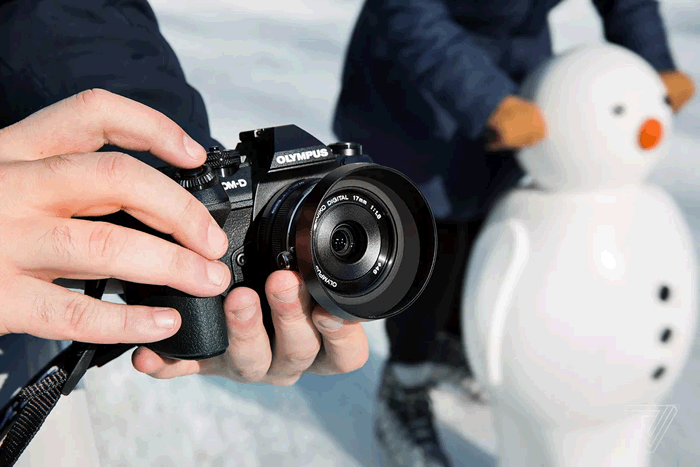Let’s do the time warp again…with the camera that warps time
We all experience moments in our lives where we wish we could stop or slow down time. It could be as simple as when your phone slips out of your grasp, or as heart-stopping as when an accident is about to happen. It’s like you’re watching things happen in slow motion, and yet you can’t make your body respond fast enough to do anything about it.
A similar thing happens in photography. Because with photography you’re not just fighting human reaction time, you’re also dealing with the camera’s reaction time. When you spot something you want to capture — a funny thing someone’s doing, the way the light is reflecting off of a building — you have to react quickly, and your gear has to be fast, too.
Luckily, digital cameras have been getting a lot faster over the last few years, and they started to reach a new level in 2016. Sony one-upped the already fast A6300 when it released the A6500, which can focus in less than a tenth of a second and can shoot 11 frames per second.
But it’s the new $2,000 Olympus OM-D EM-1 Mark II that has set the bar for speed going forward. It’s somehow quicker than the Sony A6500, and it has a particular shooting mode that essentially changed the way to approach shooting stills. The result is not just that the EM-1 Mark II is fast. It’s that with it, you feel like you can manipulate time.
The Mark II is the second version of Olympus’ flagship Micro Four Thirds camera, the E-M1, which was released in 2013. And while the company is still using this small and somewhat outmatched sensor format — a full frame sensor captures almost four times as much information as a typical Micro Four Thirds sensor — Olympus’ cameras have come a long way in the three years since the first E-M1 was released.
For one thing, in that time Olympus found a way to squeeze an extra 4,000,000 pixels into its Micro Four Thirds sensors, bumping the resolution from 16 to 20 megapixels.
The E-M1 also has 40 more autofocus points than its predecessor, a better battery, and a new generation of image processor. It even shoots 4K video.
Olympus has also refined its hardware design chops since the last E-M1, with this year’s Pen-F serving as the shining example — the classic-looking digital camera is one of the prettiest cameras released by a company not named Fujifilm in years. The E-M1 Mark II benefits greatly from this refined approach to hardware. It’s all-metal and weather-sealed, and it is a joy to hold in your hands. It feels solid as a rock for such a small camera, but it also isn’t overly heavy.
One thing that stayed the same is the E-M1’s electronic viewfinder. It’s serviceable — just not as fantastic as the ones you find on Sony’s, or even Fujifilm’s highest-end cameras these days. The 2.36-million dot screen feels a bit small and not quite as sharp as the competition, though the camera does have a very deep eye cup that lets you get lost in the EVF. When you have to struggle to line your eye up with the viewfinder, because it increases the chance of missing a shot. The E-M1’s EVF causes none of those problems.
What makes the E-M1 Mark II so special, though, is the camera is fast. Fast like before-you-finish-reading-the-end-of-this-sentence-it-could-have-taken-more-than-100-photos fast. Even the E-M1 Mark II’s slowest modes feel speedier than most other cameras’ fastest.
How fast are we talking? The Mark II tops out at 15 frames per second, RAW or JPG, when using the mechanical shutter. If you use the electronic shutter, though, you can shoot at a rate of 60 frames per second. These sequential shooting modes are customizable, too, so you don’t have to shoot as fast as 60fps — you could shoot at a more reasonable 30 frames per second with the electronic shutter if you’re not feeling totally rowdy.
Like with any kind of speed, there are limits. You can only shoot a max of about 50 frames of RAWs or JPGs when shooting at that maxed-out 60 frames per second speed. Shooting at 15 frames per second with the mechanical shutter, the camera will capture up around 80–90 RAWs or about 120 JPGs. This is somewhere the Sony A6500 actually beats the E-M1 Mark II; at its max speed of 11 frames per second, the A6500 can shoot straight through for more than 300 images.
But the E-M1 Mark II’s limits don’t diminish the power you wield with shooting speeds this fast — there are times when you want to be able to rattle off 50 frames in under a second at full resolution, and until now that was an extremely hard thing to do. Some digital cameras — even some made by Olympus — have previously allowed 30 frames per second capture when using electronic shutter, but those modes (usually marketed as “4K Photo”) always came with a tradeoff in resolution — you weren’t capturing the full readout of the image sensor.
For those whose best friend is burst mode, the speed of the E-M1 Mark II means that multiple images shot in these high-speed burst modes look so similar, the result of the pictures being taken so quickly and closely together. It’s genuinely hard to discern one photo from the next at 60 frames per second.
With that in mind, technological limits on the E-M1 Mark II’s speed are almost a help. Dealing with hundreds of photos taken a 1/60th of a second apart is a logistical nightmare, especially if you shoot that way often.
More information: The Verge



Comments are closed, but trackbacks and pingbacks are open.